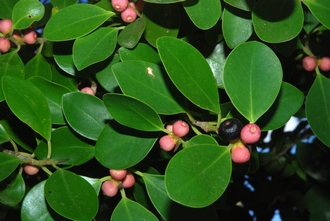Botanical name: Ficus microcarpa | Hindi: कामरूप | Marathi: नांदरूख | English: Indian Laurel Fig
About
The Indian Laurel Fig (Ficus microcarpa) is an evergreen tree with glossy, elliptical leaves and a spreading canopy. Belonging to the Moraceae family, it can reach heights of 20 meters. Its trunk is often buttressed, and aerial roots may descend from its branches, forming additional support. The small, greenish fruit is a syconium, a unique fig structure.Interesting Facts

Medicinal Uses: In traditional medicine, various parts of the Indian Laurel Fig are used for their potential medicinal properties. Extracts from leaves and roots are believed to possess anti-inflammatory and anti-diabetic effects. They are also utilized in formulations targeting respiratory ailments and skin conditions.

Environmental Impact: Indian Laurel Figs contribute to the environment by providing shade, reducing soil erosion with their complex root systems, and offering habitats for various species. Additionally, their ability to thrive in urban environments makes them valuable for urban greenery and biodiversity. The tree’s adaptability to different climates and resistance to pests enhances its ecological role, promoting a sustainable balance in various ecosystems.
Anandvan Trivia Quiz
Question 1: Have you heard about “Fig & Fig Wasp Mutualism”?Answer: The relationship Fig trees hold with wasps is quite remarkable. There are about 750 species of figs, each of which has a particular fig wasp as its pollinator. When the female flowers inside the immature fruit are ready for pollination the fig emits an enticing aroma that attracts only female wasps of the specific type for that tree. The wasp helps the fig by transferring pollens collected from a previous fig where it was born to the new fig. The fig helps the wasp by providing a place to lay eggs and feed it’s larvae. This incredible partnership requires a very fine tuning and synchronicity on the part of the plant and of the pollinator. It is often mentioned as a fine example of coevolution and termed as “Mutualism”.

